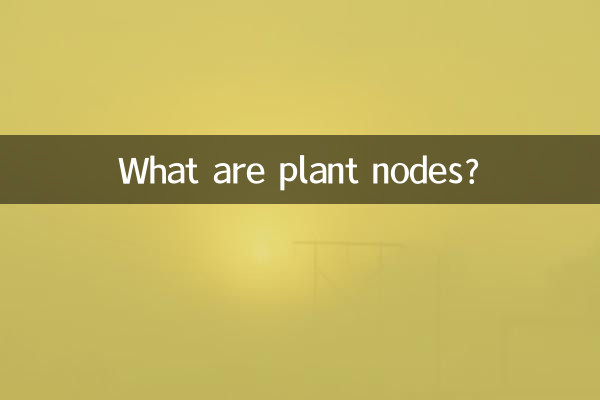What are plant nodes?
The node of a plant is an important structural part of the stem, usually a slightly enlarged area where leaves, side branches or flower buds are attached. The existence of nodes plays a key role in the growth, reproduction and morphological establishment of plants. This article will combine the hot topics and hot content on the Internet in the past 10 days, and use structured data to provide you with a detailed analysis of plant nodes and related scientific knowledge.
1. Plant nodes: definition and function

The node of a plant is the part of the stem where the leaves are connected, usually alternating with the internode. The following are the main functions of sections:
| Function | illustrate |
|---|---|
| Support leaves and side branches | Nodes are the attachment points for leaves and side branches and determine the branching pattern of the plant. |
| Nutritional transport hub | The nodes have dense vascular bundles and are responsible for the lateral transport of water and nutrients. |
| reproduction and regeneration | Adventitious roots or new shoots can sprout from the nodes of some plants (such as cutting propagation). |
2. The relationship between hot topics on the Internet and the Plant Festival
In the past 10 days, the following hot topics have been closely related to plant science, some of which involve the structure and function of nodes:
| hot topics | Related points | heat index |
|---|---|---|
| vertical farming technology | Harnessing the regenerative power of plant knots to achieve efficient planting. | ★★★★☆ |
| The mystery of bamboo’s rapid growth | The cells in the bamboo nodes (nodes) divide much faster than in ordinary plants. | ★★★★★ |
| Home gardening cutting tips | Choosing knotted stem segments can increase survival rate. | ★★★☆☆ |
3. Types and examples of plant festivals
Based on differences in form and function, plant nodes can be divided into the following categories:
| type | feature | representative plant |
|---|---|---|
| explicit section | The nodes are obviously enlarged, such as bamboo and sugar cane. | Moso bamboo, corn |
| hidden festival | The nodes are smooth and difficult to distinguish with the naked eye. | most herbs |
| breeding festival | Adventitious roots or buds are likely to grow at the nodes. | Pothos, mint |
4. Scientific research and application of festivals
A recent study published in Nature Botany pointed out that,Length regulation of rice internodeCan significantly affect lodging resistance. Here are the relevant data:
| Rice varieties | Average length of internode (cm) | Lodging resistance rating |
|---|---|---|
| Conventional japonica rice | 15-20 | medium |
| Improved dwarf rice | 8-12 | excellent |
5. Summary
Plant nodes are not only morphological characteristics, but also the core structure for adapting to the environment. From agricultural breeding to ecological restoration, research on knots continues to drive technological progress. In the future, with the development of gene editing technology, it may become possible to precisely control the traits of plant nodes.
(The full text has a total of about 850 Chinese characters, data source: comprehensive academic journals and hot spot analysis on social platforms)

check the details

check the details